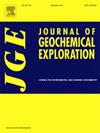Drinking water quality in the Malaysian indigenous community of Pos Kemar (Perak): Pollution, risks, and household practices
IF 3.3
2区 地球科学
Q1 GEOCHEMISTRY & GEOPHYSICS
引用次数: 0
Abstract
Access to clean water continues to be a major obstacle for indigenous communities in remote areas. The objective of this study is to evaluate the extent of pollution in the drinking water of the indigenous tribe community of Pos Kemar (Malaysia), specifically examining the issue of microbiological contamination and the resulting health hazards. Drinking water samples were collected from 108 households and analysed for physicochemical parameters, heavy metals, and microbial contamination, particularly Escherichia coli (E. coli). In addition, a questionnaire study was carried out to investigate behaviour related to water handling, hygiene, and reported health complaints. The results indicated that although the majority of physicochemical and heavy metal levels were within the Malaysian Drinking Water Quality Standards, the presence of microbiological contamination, namely E. coli, greatly beyond the safely acceptable thresholds in all samples. According to a simplified Quantitative Microbial Risk Assessment, all samples exceeded the World Health Organization health-based target for pathogenic E. coli, indicating a significant health risk from E. coli infection. The study further revealed that effective water treatment, such as boiling, substantially decreased levels of pollution. Nevertheless, deficiencies in water management protocols and sanitation were identified, which greatly contributed to the high occurrence of waterborne illnesses. Specifically, 31 % of the population reported experiencing health symptoms related to inadequate water quality, such as diarrhea and skin infections. The results emphasize the immediate requirement for enhanced water treatment measures and public health approaches to reduce the hazards of waterborne illnesses in indigenous populations.
马来西亚波基玛尔(霹雳州)土著社区的饮用水质量:污染、风险和家庭习惯
获得清洁水仍然是偏远地区土著社区面临的主要障碍。这项研究的目的是评估Pos Kemar(马来西亚)土著部落社区饮用水中的污染程度,具体审查微生物污染问题及其造成的健康危害。从108个家庭收集了饮用水样本,并分析了理化参数、重金属和微生物污染,特别是大肠杆菌。此外,还进行了一项问卷调查,以调查与水处理、卫生和报告的健康投诉有关的行为。结果表明,虽然大部分物化和重金属含量都在马来西亚饮用水质量标准之内,但所有样品中存在的微生物污染,即大肠杆菌,大大超出了安全可接受的阈值。根据简化的定量微生物风险评估,所有样本均超过世界卫生组织致病性大肠杆菌的健康指标,表明大肠杆菌感染存在重大健康风险。该研究进一步表明,有效的水处理,如煮沸,大大降低了污染水平。然而,人们发现在水管理规程和卫生方面存在缺陷,这在很大程度上导致了水媒疾病的高发生率。具体而言,31%的人口报告出现了与水质不佳有关的健康症状,如腹泻和皮肤感染。研究结果强调,迫切需要加强水处理措施和公共卫生措施,以减少土著人口中水传播疾病的危害。
本文章由计算机程序翻译,如有差异,请以英文原文为准。
求助全文
约1分钟内获得全文
求助全文
来源期刊

Journal of Geochemical Exploration
地学-地球化学与地球物理
CiteScore
7.40
自引率
7.70%
发文量
148
审稿时长
8.1 months
期刊介绍:
Journal of Geochemical Exploration is mostly dedicated to publication of original studies in exploration and environmental geochemistry and related topics.
Contributions considered of prevalent interest for the journal include researches based on the application of innovative methods to:
define the genesis and the evolution of mineral deposits including transfer of elements in large-scale mineralized areas.
analyze complex systems at the boundaries between bio-geochemistry, metal transport and mineral accumulation.
evaluate effects of historical mining activities on the surface environment.
trace pollutant sources and define their fate and transport models in the near-surface and surface environments involving solid, fluid and aerial matrices.
assess and quantify natural and technogenic radioactivity in the environment.
determine geochemical anomalies and set baseline reference values using compositional data analysis, multivariate statistics and geo-spatial analysis.
assess the impacts of anthropogenic contamination on ecosystems and human health at local and regional scale to prioritize and classify risks through deterministic and stochastic approaches.
Papers dedicated to the presentation of newly developed methods in analytical geochemistry to be applied in the field or in laboratory are also within the topics of interest for the journal.
 求助内容:
求助内容: 应助结果提醒方式:
应助结果提醒方式:


